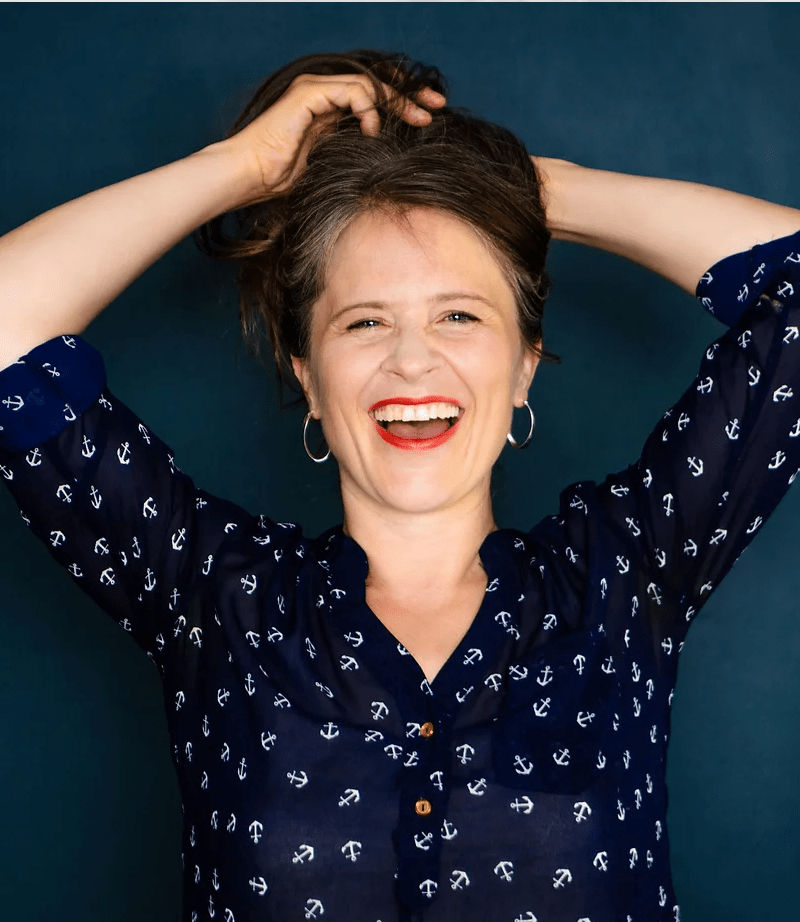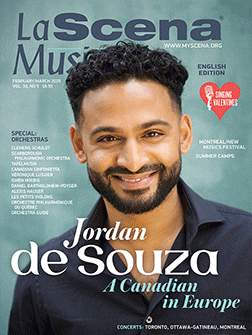This page is also available in / Cette page est également disponible en:
![]() Francais (French)
Francais (French)
On May 30, audiences at Bourgie Hall will hear new works by three female composers, created in partnership with three female librettists. Each opera, from a different backgrounds and in a different styles, was made possible thanks to Montreal granting organisation Musique 3 femmes.
Nanatasis
Originally from Mexico, Alejandra Odgers’ fondness Abenaki myths and legends began the day she first heard Nicole O’Bomsawin sing. It was in 2007, during a sugar-shack meal with friends at the Maison autochtone de Saint-Hilaire, she recalls. At the time, Alejandra was preparing a concerto for voice as part of her doctorate at the Université de Montréal, and had been thinking about texts by the indigenous peoples of her home country, written in languages that are unfortunately disappearing.
“I fell in love with several of Nicole’s songs – I told myself that I had to go back to record them, and talk to her. My research into traditional Mexican music was going to be difficult, especially at a distance. But here I had someone in the flesh who was willing to share [her culture].” Alejandra and Nicole thus began a fruitful collaboration, which has led to several art songs and arrangements, including two pieces for orchestra: Toni alosaan and, more recently, Menahanis, premiered by the Orchestre Métropolitain at Parc Jean-Drapeau in June of 2019.

Nicole O’Bomsawin
“I was immediately drawn to the Musique 3 femmes call for entries. The idea was to compose an opera, but in a very broad sense – a story told through music. It aligned perfectly with what Nicole and I wanted to do,” notes Alejandra. Their joint project is called Nanatasis, which means ‘hummingbird’ or ‘bird fly.’ It’s also the nickname that Nicole’s grandparents gave her, as per the Abenaki tradition whereby children are given a nickname around the age of 6, usually when they lose their first tooth, explains Alejandra.
On May 30, at Bourgie Hall, listeners will hear one of three legends set to music, Nee-ben and Pe-ben, or the incarnation of summer and winter. Short Abenaki songs are integrated into the opera. “In composition, you have to have a wide range of tools. I’ve done pieces that are completely atonal, some modal, some tonal and some electroacoustic. As I conceive of a piece, I ask myself what musical language, what method will achieve what I am envisioning? It’s not unusual for me to look to melodic writing. There’s always something that will catch the ear. Because of my roots, dance rhythm and percussion are very important to me. Ultimately, I didn’t have to make any sacrifices to combine my compositional style with the the Abenaki source material.”
Raccoon Opera
Composer Rebecca Gray, for her part, chose to tackle very contemporary subject matter, with universal relevance. In collaboration with her sister Rachel as librettist, she decided to address the housing crisis in Toronto, which she herself experienced when living there. More broadly, the work condemns the brutality of capitalism, and the vulture mentality of both building owners and landlords, who will stop at nothing to evict occupants for personal gain. Rebecca Gray uses the raccoon as a symbol of this moral precarity: “No matter what we throw at them, they always find a place to live, they always find a way to make it work,” she says.

Composer Rebecca Gray
In Raccoon Opera, a tenant named Erin falls prey to this unscrupulous animal. “The raccoon tells her that she deserves better. The raccoon and her together they can take over the apartment, they can help Erin rise above the grinding city and she can be clean and powerful and do all these things. They have various music moments that bring their intimacy closer together. But it’s a fable. In the end, the raccoon has played a big trick. The raccoon is the one who takes over the apartment and (…) Erin’s mind and body – it’s very dark.” she says.
The two sisters were attracted to the idea of making an animal that was not only human-sized, but also had human characteristics, sing. “It allows us to hover these interesting contemporary topics, but it doesn’t feel didactic because it’s an animal singing. We were able to do it without being too realistic. My way of writing opera does not fit with realism. I’m interested in seeing the housing crisis and bringing it to the absolute extremes.”

Librettist Rachel Gray
The audience will only see two-thirds of the show, says the composer, bringing them up to the moment when Erin commits to her project with the raccoon. I was inspired by the relationship between Iago and Othello (in Verdi’s opera) and the kind of vow they make together. I’m referencing that moment. The opera also has a Faustian vibe: the deal with the devil, the devil in disguise. I’m very drawn to these over-the-top things that opera does so well and hopefully those moments of pain that opera also covers.”
The orchestral musicians contribute to the opera’s dense sound universe with all kinds of effects, but also – and this is uncommon – by speaking and singing themselves. Some moments with the raccoon are lyrical, almost romantic. Others, on the other hand, represent the ceaseless chaos of the city. In addition to the piano, percussion, violin, cello and clarinet, the trumpet plays a particularly important role in the music: “It’s a regal instrument and it’s really tied to the raccoon with the idea of projecting brilliance. With extended techniques, it can also make the most amazing, deranged sounds.”
Je suis la fille de la fille
Before even considering composing an opera, Analía Llugdar had the idea of writing a work for voice and flute. For this project, initiated in partnership with flutist Josée Poirier, she was looking for a Quebecois poem. In the end, it was a collection of poems by Lebanese-born author Emné Nasereddine, La danse du figuier (2021), that caught her eye.
“Emné knew how to find the right words, without artifice. Her style was minimalist, but with depth. You could feel it came from the heart. She came to Montreal, leaving her country of birth, for reasons that are certainly different from mine, but we have each experienced the process of immigration. Maybe that’s the story of all immigrants: you can find a new place, feel at home there, and still remember your culture, your grandmothers’ heritage… all those little things that make up who you are, that are part of your identity.”

Composer Analía Llugdar
Emné Nasereddine agreed to work on an opera libretto combining several extracts from her collection, transforming and re-transforming them to create a narrative thread, a story, that Analía Llugdar could set to music. Three women — the daughter, the mother and the grandmother – are embodied by a single voice that brings them all together, representing an awareness that the daughter will one day become a mother, and then a grandmother.
The title of the work, Je suis fille de la fille (I am the daughter of the daughter, in English), assumes its full meaning. “That was the most difficult part for me in terms of writing: finding different colors in a single vocal timbre, so that I could personify all of these women. It wasn’t a question of register, high or low. The essential thing was to find each one’s own character, and then how it might be sung. The girl is dreamy at times, but also angry. She’s restless. On the other side of the spectrum, there’s the grandmother who, despite the difficulties, is affectionate. She is calm and serene. The mother stands behind her daughter, guiding her, telling her what to do and what not to do. It’s in the musical characterization, the interpretation, the rhythm and even the silences that I tried to build these women.”
The grandmother’s score is the most melodic, admits the composer. “I’ve never written anything so melodic. I don’t recognize myself at times,” she laughs. “It’s as if something drew me to this style, perhaps out of respect for this lady, her breaths, her reasons for expressing herself.”
For this, her first opera of this scope, Analía Llugdar confides that she learned a lot from listening to classical opera. “In terms of dramaturgy, I went back to Mozart. He knew how to write for each character in a different way. From popular music, more sustained soprano writing, a style close to Lieder… all these things that seem caricatured to some are, in fact, not caricatured at all. These subtle differences, which Mozart manages to write into his operas, allow the listener to instantly distinguish between characters. He is among the best composers at capturing drama in music, and the pleasure he takes in playing with his characters is palpable.”
Conclusion
Analía Llugdar, Alejandra Odgers and Rebecca Gray all met through Musique 3 femmes, an organization that gave them the chance to stage an opera and thus supported, as producers, these women’s creative work. Analía Llugdar remembers the pleasure of discussing each of their three projects amongst each other. “We’re all very different, and that’s what I find so wonderful. It will certainly be very contrasting for the audience at Bourgie Hall. We are all deeply grateful to Musique 3 femmes for this opportunity. Exploring operatic composition is not easy. It requires a significant investment.”

Kristin Hoff, General Director & Interim Artistic Director of Musique 3 femmes
Je suis fille de la fille, Raccoon Opera and Nanatasis are three commissions from Mécénat Musica Prix 3 Femmes, with the support of Canada Council for the Arts. For tickets, please visit the webpage of the concert: www.mbam.qc.ca/en/activities/opera-of-today/
This page is also available in / Cette page est également disponible en:
![]() Francais (French)
Francais (French)















